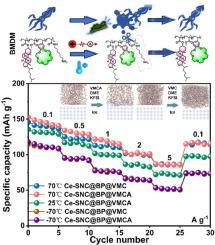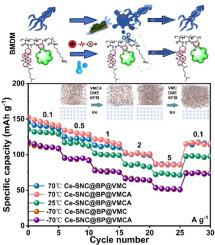Conformational gearing of black phosphorus anode via biomimetic adaptive mechanism for fast charging and low-temperature adaptability in potassium batteries
IF 20.2
1区 材料科学
Q1 CHEMISTRY, PHYSICAL
引用次数: 0
Abstract
Black phosphorus (BP) is emerging as a promising anode material with high theoretical capacity in potassium-ion batteries. However, its limited synergy between rapid charging capability and broad temperature range compatibility severely restricts its practical deployment. To address this, we have developed a strategy based on "point-line-face" conformational tailor, incorporating dynamic protective mechanism, i.e., a biological metamorphosis defense mechanism (BMDM), to harmonize fast-charging kinetics and low-temperature adaptability. For the first time, BP is firstly encapsulated within an "S, N co-doped vesicle-like" carbon matrix with spatial expanding channels, fortified with Ce single atoms to achieving 4f-3p-5d orbital hybridization towards for the fine plane K deposition based on hard base-soft acid theory, further integrated into a polymer structure featuring dedicated biomimetic escaping feature derived from the eco-friendly conversion of plexiglas waste. This enables an intelligent adaptation, where one side chain is selectively truncated to enhance kinetic behavior, accommodating high C-rates and low-temperature conditions. This innovative protocol paves the way for the design of delicate electrode materials at the intersection of energy, biology, and environmental science, transforming polluting waste into valuable energy-storage components, and essentially explores the self-adaptive framework reconstruction to smartly accommodate the arduous C-rates and low temperature conditions.


基于仿生自适应机制的黑磷阳极快速充电和低温适应性的构形调整
黑磷作为一种具有较高理论容量的负极材料在钾离子电池中崭露头角。然而,它在快速充电能力和宽温度范围兼容性之间有限的协同作用严重制约了它的实际部署。为了解决这一问题,我们开发了一种基于“点-线-面”构象定制的策略,结合动态保护机制,即生物变态防御机制(BMDM),以协调快速充电动力学和低温适应性。首次将BP封装在具有空间扩展通道的“S, N共掺杂囊泡样”碳基质中,并添加Ce单原子,实现基于硬碱-软酸理论的4f-3p-5d轨道杂化,以实现精细平面K沉积,并进一步整合到具有仿生逃逸特性的聚合物结构中,该聚合物结构源自有机玻璃废弃物的环保转化。这实现了智能适应,其中一个侧链被选择性截断,以增强动力学行为,适应高碳率和低温条件。这一创新方案为在能源、生物和环境科学交叉领域设计精致的电极材料铺平了道路,将污染废物转化为有价值的储能组件,并从本质上探索了自适应框架重建,以巧妙地适应艰苦的c率和低温条件。
本文章由计算机程序翻译,如有差异,请以英文原文为准。
求助全文
约1分钟内获得全文
求助全文
来源期刊

Energy Storage Materials
Materials Science-General Materials Science
CiteScore
33.00
自引率
5.90%
发文量
652
审稿时长
27 days
期刊介绍:
Energy Storage Materials is a global interdisciplinary journal dedicated to sharing scientific and technological advancements in materials and devices for advanced energy storage and related energy conversion, such as in metal-O2 batteries. The journal features comprehensive research articles, including full papers and short communications, as well as authoritative feature articles and reviews by leading experts in the field.
Energy Storage Materials covers a wide range of topics, including the synthesis, fabrication, structure, properties, performance, and technological applications of energy storage materials. Additionally, the journal explores strategies, policies, and developments in the field of energy storage materials and devices for sustainable energy.
Published papers are selected based on their scientific and technological significance, their ability to provide valuable new knowledge, and their relevance to the international research community.
 求助内容:
求助内容: 应助结果提醒方式:
应助结果提醒方式:


